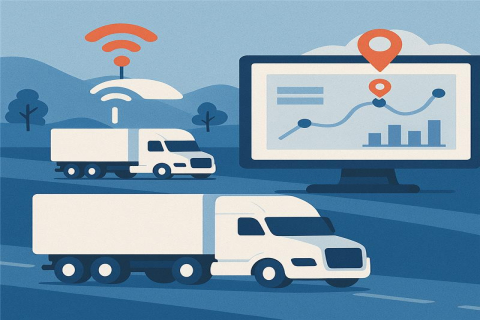How Autonomous Trucking Systems Are Integrating with Transport Management System: What 2025 Users Need to Know
The logistics industry in 2025 isn’t just about trucks on the road. It’s about systems that keep freight flowing without constant human intervention. Autonomous trucking systems are transforming how businesses run operations. Instead of manual updates and fragmented tools, businesses now expect seamless autonomous trucking system integration with TMS for real-time visibility, automated dispatching, and measurable ROI
A big part of this transformation comes from platforms like Xfrate’s Transport Management System (TMS), designed to connect businesses and transporters through one cloud-based freight platform. Let’s break down what integration means, why it matters, and how it reshapes trucking operations in 2025.
Why Autonomous Trucking System Integration with TMS Matters
For carriers, the first question is always ROI. What difference does an autonomous trucking ROI model actually make? The short answer: a lot.
With autonomous trucking TMS integration, you eliminate the lag of manual reporting, reduce scheduling errors, and gain real-time trucking visibility across every lane. Businesses using TMS typically see utilization improvements and cost-per-mile reductions, and also benefit from better on-time delivery and fewer missed SLAs.
Xfrate TMS adds another layer here: built-in analytics highlight where automation delivers savings, while centralized bidding workflows ensure that businesses optimize contracts and loads in the same place.
How an Autonomous Trucking System Shows Up in a TMS
So what does integration look like on your dashboard? In a modern TMS, every autonomous-enabled truck is modeled as an asset with its own telemetry feed. Instead of calling drivers for updates, you get continuous autonomous trucking system telemetry data—location, fuel consumption, route progress, and load status—directly mapped into your TMS.
With Xfrate TMS, you don’t just see pins on a map. You get predictive ETAs, exception alerts, and order tracking that make your supply chain decisions faster and more reliable. It’s about turning raw telematics into business intelligence.
Technical Integration: APIs, Webhooks, and Secure Data Flows
Behind the scenes, integration depends on technology. To connect an autonomous trucking system to a TMS, you’ll need APIs for data exchange, webhooks for instant updates, and message queues to handle telemetry spikes.
Security and standardization also matter. Whether it’s JSON, XML, or other formats, consistency ensures your TMS can handle different fleets and vendors without breaking workflows.
That’s why Xfrate’s API-first TMS is critical—it’s built to integrate quickly with third-party systems, from telematics providers to autonomous trucking platforms, without heavy customization.
Dispatching and Scheduling: Smarter Workflows
Dispatching is where change hits hardest. Traditional workflows rely on human schedulers, but autonomous truck dispatch in TMS means most assignments are generated automatically based on telemetry, availability, and lane rules.
Instead of firefighting, dispatchers now manage exceptions—reassigning loads when disruptions occur, or balancing human and autonomous assets in real time.
Xfrate’s automated dispatch tools make this process easier by using predictive scheduling, ensuring hybrid fleets are always optimized.
Compliance, Safety, and Guardrails
Every fleet manager knows compliance can’t be overlooked. That’s why autonomous trucking compliance in TMS is so important. From digital proof-of-delivery to real-time incident reporting, your TMS must embed compliance and safety guardrails.
Xfrate TMS integrates compliance workflows directly into scheduling and order management, giving you built-in audit trails and reducing manual checks.
Real-World Examples of TMS and Autonomous System Integration
The logistics industry is already moving fast.
● Aurora has partnered with McLeod Software to bring autonomous trucking TMS integration into live operations.
● Kodiak Robotics has teamed with Werner Enterprises for scalable pilot programs that prove hybrid operations can work.
These examples highlight how TMS platforms are no longer passive—they’re becoming the nervous system of modern freight networks.
Xfrate follows a similar philosophy, bringing businesses together on a cloud-based freight platform so both sides see value from automation.
Preparing for the Future of Autonomous Trucking Systems2025 is the year when autonomous trucking system TMS integration stops being optional. Fleets that move early get ROI faster, reduce compliance risks, and gain competitive advantage. Those that wait will be playing catch-up.
The shift isn’t just coming, it’s already here.
With platforms like Xfrate TMS, you don’t have to gamble. You get a cloud-based transport management system that supports you in one ecosystem that is ready for autonomous integration, hybrid fleets, and the compliance demands of tomorrow.
Frequently asked questions
What is an autonomous trucking system and how does it work with a TMS?
An autonomous trucking system automates fleet tracking, dispatch and optimization; when it connects to a TMS it streams telemetry, automated events and status updates so you can manage loads without manual check-ins. Choosing a TMS with centralized order management and prebuilt telemetry connectors makes integration faster and reduces configuration risk.
What ROI can carriers expect from autonomous trucking system TMS integration?
Carriers can expect improved utilization, fewer manual dispatch hours and clearer cost-per-mile visibility. When a TMS also supports bidding and analytics, you capture savings in tendering and operational decisions, which can translate to measurable cost reductions and faster payback.
How do dispatch workflows change with autonomous trucking systems?
Dispatch becomes rules and telemetry driven: the system schedules based on asset capability, route restrictions and real-time status while dispatchers focus on exceptions and higher-value decisions. Platforms that factor both human and automated assets into scheduling help you run hybrid fleets more efficiently.
For more details, please contact us at: contact@xfrate.com

